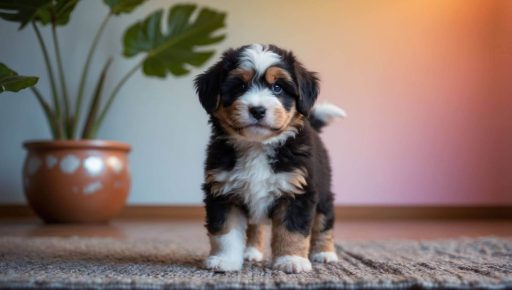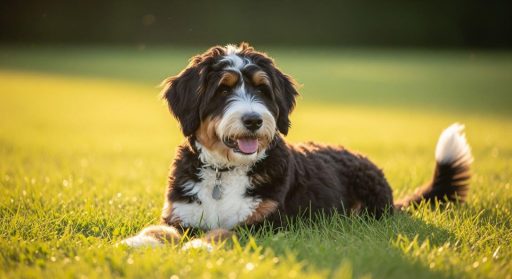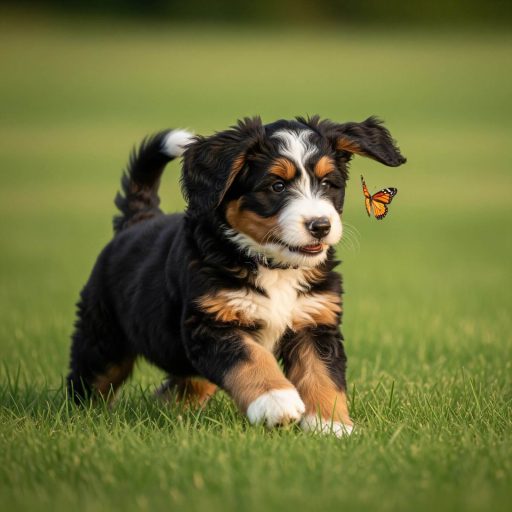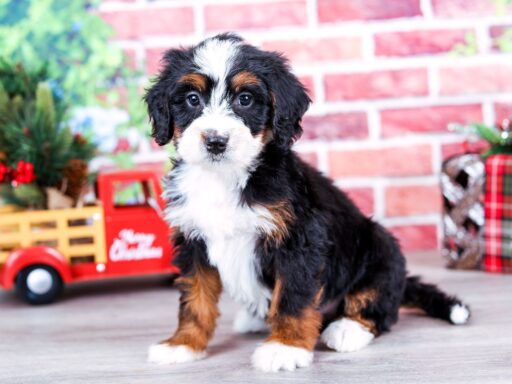If you’re looking for a Bernedoodle with reliable traits in coat, temperament, and behavior, the F3 generation is worth a closer look. These dogs are what breeders call “multigen,” meaning they’re born from two Bernedoodle parents, not from a direct Bernese Mountain Dog and Poodle mix.
Because both parents are already part of the breed, their puppies are more likely to inherit the classic Bernedoodle traits, like low-shedding coats, friendly temperaments, and strong trainability, rather than a random mix of features. That means fewer surprises as your puppy grows up, especially when it comes to grooming needs, personality, and energy level.
In this guide, we’ll walk you through how F3 Bernedoodles are bred, what they look like, how to care for them, and what to expect if you’re thinking about bringing one home.
Key Takeaways
✔ F3 Bernedoodles are multigenerational, bred from two Bernedoodle parents for more consistency in coat, temperament, and behavior.
✔ They’re typically low-shedding, allergy-friendly, and easier to predict in terms of size and grooming needs.
✔ Most F3s are gentle, intelligent, and quick to adapt to routines, making them a strong choice for families and first-time dog owners.
✔ Grooming routines help prevent matting and keep the coat comfortable as they grow into their adult texture.
✔ Central Illinois Doodles raises every F3 puppy with a focus on health, early socialization, and lifelong breeder support.
What Is an F3 Bernedoodle?

An F3 Bernedoodle, also called a third-generation or multigenerational Bernedoodle, comes from two Bernedoodle parents. These parents are usually F1B, F2, or even other multigen combinations, meaning the Bernese Mountain Dog and Poodle bloodlines have already blended for a few generations.
This typically results in puppies with more consistent coat types and personalities than earlier generations. While those earlier generations can swing more toward one parent breed or the other, F3s often land right in the middle, bringing together the best of both worlds in a more predictable way.
To help you understand where the F3 falls in the Bernedoodle generational line, here’s a quick breakdown:
What Does an F3 Bernedoodle Look Like?
F3 Bernedoodles have that classic teddy bear charm people love—soft coats, expressive eyes, and a friendly look that matches their personality. Because of their multigenerational background, their appearance tends to be more consistent than that of earlier generations.
✔️ Coat Type – Most F3s have wavy to curly coats that are low-shedding and soft to the touch. These coats usually fall somewhere between fleece and wool in texture, depending on the parents.
✔️ Colors – You’ll see a mix of solid, bi-color, and tricolor coats in shades like black and white, merle, sable, cream, chocolate, or even phantom.
✔️ Build – They typically have a balanced, athletic build; not too bulky, not too lean. Their faces often carry that signature Bernedoodle smile with a rounder Poodle-style head.

F3 Bernedoodle Size Guide
Just like earlier generations, F3s come in three main size categories. The size of the parents (especially the Poodle) usually determines where your puppy will land.
💡 Note: Coat texture and size can still vary slightly, even in multigen litters. If you have specific preferences, ask your breeder about the parent dogs and what past litters have looked like.
F3 Bernedoodle Temperament: What to Expect
F3 Bernedoodles are known for being friendly, gentle, and easy to live with. Thanks to their multigenerational background, you’re more likely to get a dog with consistent behavior—calm when it’s time to relax, playful when you’re up for fun, and always ready to be near their people.
These dogs are social by nature. They enjoy being part of the daily routine, follow their family from room to room, and tend to build strong bonds fast. If you give them time, structure, and affection, they give it right back.
Here’s what you’ll often see with F3 Bernedoodles:
✔️ Loyal Companions – They stick close, love being involved, and often form a strong bond with one or two people.
✔️ Smart and Easy to Train – They respond well to consistency and clear communication. Short, positive training sessions go a long way.
✔️ Friendly with Kids and Pets – These dogs usually fit right into family life. They’re gentle, patient, and adjust quickly to new people or routines.
✔️ Balanced Energy – F3s have just enough energy to keep things fun without feeling like you need to wear them out constantly. A daily walk and some playtime usually do the trick.
✔️ Emotionally Aware – Many owners say their Bernedoodles seem to “read the room” and pick up on how people are feeling. It’s one of the reasons they’re often considered intuitive dogs.
🐶 Like any breed, early socialization and consistency shape their behavior over time. But if you raise an F3 Bernedoodle in a loving, structured environment, they tend to grow into calm, reliable companions that settle in easily.
How to Groom an F3 Bernedoodle
F3 Bernedoodles usually have coats that are soft, curly, and low-shedding, but those curls don’t manage themselves. Without regular grooming, mats and tangles build up fast, especially around high-friction areas like the ears, legs, and underarms.
If you keep up with coat care from the start, your dog will not only look great but also feel more comfortable day to day.
Here’s what a good grooming routine should include:
💡 Tip: Start grooming early, even while your puppy still has a softer coat. That way, they’ll get used to being handled and won’t fuss as much once their adult curls grow in.
Health Considerations for F3 Bernedoodles
F3 Bernedoodles are generally healthy dogs, especially when they come from breeders who prioritize health testing and responsible pairings. Still, like all breeds, there are a few conditions to be aware of, most of them inherited from their Bernese or Poodle lineage.
Knowing what to look out for can help you stay ahead of any issues and keep your dog thriving well into their senior years.
Here are a few health considerations to keep in mind:
✔️ Hip and Elbow Dysplasia – Larger F3s, especially standards, can be prone to joint problems. Reputable breeders screen for this to reduce the risk.
✔️ Eye Conditions – Progressive Retinal Atrophy (PRA) and cataracts can appear in some lines. Regular checkups help catch changes early.
✔️ Allergies and Skin Sensitivities – Their curly coats can trap dirt and moisture if not groomed often, which sometimes leads to itching or hotspots.
✔️ Bloat (Gastric Torsion) – This is more of a concern in larger dogs with deep chests. Feeding smaller meals and avoiding vigorous exercise right after eating can help lower the risk.
✔️ Long-Term Care – Keep up with vet visits, annual bloodwork, and regular dental cleanings. Like people, early detection leads to better outcomes.
🩺 Good to know: When F3 Bernedoodles are raised with health-tested parents and solid early care, they tend to enjoy a long, active life, often reaching 12 to 16 years with proper diet, exercise, and preventative vet care.
Why Choose an F3 Bernedoodle?
F3 Bernedoodles have become a popular choice for families who want a dog that’s steady, smart, and easy to live with. Because they’re bred from multiple generations of Bernedoodles, their traits tend to stay more consistent. That means you can get a better sense of what your puppy will be like, both in how they look and how they behave.
Here’s why many people lean toward this generation:
✔️ More Predictable Traits – Coat texture, shedding levels, and temperament are often easier to gauge. That’s helpful if you’ve got allergy concerns or specific preferences for energy level and grooming needs.
✔️ Calm, Friendly Personality – F3s tend to be well-balanced. They’re affectionate without being clingy, playful without being wild, and settle easily into household routines.
✔️ Easier to Train – Their sharp minds and eagerness to connect make them great for obedience work, crate training, and even advanced tricks.
✔️ Adjust Easily to Busy Homes – F3 Bernedoodles usually settle in quickly with kids, guests, and other pets.
💡 Note: Most families choose this generation because they want a dog that’s allergy-friendly, predictable, and not too high-maintenance in daily life.
How We Raise Our F3 Bernedoodle Puppies
At Central Illinois Doodles, we raise each puppy with intention and care. Our goal is to give them the best start possible so they can grow into calm, confident dogs who adjust easily to family life.
Here’s how we raise our F3 Bernedoodles:
✅ Health Comes First – At Central Illinois Doodles, we health test every parent dog before breeding. This includes checks for hips, elbows, eyes, and known genetic conditions common in Bernese and Poodle lines. We only pair dogs with strong, stable traits that meet our breeding standards.
✅ Early Socialization – Our puppies are raised in a hands-on, family-centered environment. They’re introduced to people, household noise, and gentle handling from the start. We also expose them to age-appropriate challenges that help build confidence and emotional stability.
✅ Clean, Calm Environment – Our puppies are raised in a quiet, well-organized setting with plenty of space to move, play, and rest. We keep their area clean and structured so they feel secure from day one. This makes it easier for them to adjust once they join your home.
✅ Support That Doesn’t End at Pickup – When you get a puppy from us, you’re not left on your own. We’re available for questions, advice, and honest feedback any time—even after your pup is settled in. We want every family to feel confident, not overwhelmed.

🐾 Puppies raised with structure, attention, and gentle guidance grow into companions who feel right at home from day one.
Final Thoughts on the F3 Bernedoodle
Choosing an F3 Bernedoodle means bringing home a dog that’s easy to live with, responsive to training, and naturally affectionate. Their multigenerational background gives them a level of consistency that makes life a little easier, especially when it comes to coat care, personality, and daily routines.
At Central Illinois Doodles, we raise every puppy with structure, patience, and plenty of early socialization. That way, when it’s time to bring your pup home, you’re not starting from scratch; you’re welcoming a dog that’s already been set up for a smooth transition.
🐾 Take a look at our available puppies or reach out to ask questions. We’re happy to walk you through the process and help you find the right match for your home.
Final Thoughts on the F3 Bernedoodle
Choosing an F3 Bernedoodle means bringing home a dog that’s easy to live with, responsive to training, and naturally affectionate. Their multigenerational background gives them a level of consistency that makes life a little easier, especially when it comes to coat care, personality, and daily routines.
At Central Illinois Doodles, we raise every puppy with structure, patience, and plenty of early socialization. That way, when it’s time to bring your pup home, you’re not starting from scratch; you’re welcoming a dog that’s already been set up for a smooth transition.
🐾 Take a look at our available puppies or reach out to ask questions. We’re happy to walk you through the process and help you find the right match for your home.
Frequently Asked Questions
Do F3 Bernedoodles need a special kind of food?
Not necessarily, but a well-balanced diet is. Choose a diet with real meat as the first ingredient, and avoid fillers like corn and soy. If your dog has a sensitive stomach, you might need to try a limited-ingredient or grain-free option. Some F3 Bernedoodles do well on fresh or gently cooked food when transitioning from breeder to new home.
How do F3 Bernedoodles handle car rides and travel?
Most adjust well if introduced to car rides early. Start with short drives and reward calm behavior with treats or praise. Crate training also helps if you plan to travel often. Once they’re used to it, F3 Bernedoodles tend to be relaxed passengers who enjoy tagging along on family trips.
Are F3 Bernedoodles good for households with full-time workers?
They can be, as long as their routine includes structure and companionship. If the house is empty for long hours, consider doggy daycare, a trusted walker, or a neighbor who can check in midday. These dogs like having company, even just someone dropping by helps in how they adjust.
How long does it take for an F3 Bernedoodle to be fully potty trained?
It varies, but with consistency, many F3 puppies grasp the basics within a few weeks. Keep a set schedule, praise every successful outing, and avoid punishing accidents. Most are fully reliable by five to six months if crate training starts early.
Can an F3 Bernedoodle live in an apartment?
Yes, especially the mini and toy sizes. As long as they get daily walks and mental stimulation, they adapt well to smaller living spaces. A short morning walk, a midday break, and evening playtime usually keep them calm and content indoors.


